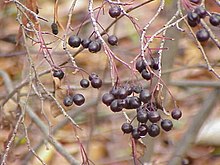Aronia, the chokeberries, are two to three species of deciduous shrubs in the family Rosaceae, native to eastern North America. They are most commonly found in wet woods and swamps. Chokeberries are cultivated as ornamental plants and also because they are very high in antioxidant pigment compounds, like anthocyanins. The name "chokeberry" comes from the astringency of the fruits, which are inedible when raw. The berries can be used to make wine, jam, syrup, juice, soft spreads, tea and tinctures. The fruits are eaten by birds, which then disperse the seeds in their droppings; birds do not taste astringency and feed on them freely.

The chokeberries are attractive ornamental plants for gardens. They are naturally understory and woodland edge plants, and grow well when planted under trees. Chokeberries are resistant to drought, insects, pollution, and disease. Several cultivars have been developed for garden planting, including A. arbutifolia 'Brilliant', selected for its striking fall leaf color. A. melanocarpa 'Viking' and 'Nero' were selected for larger fruit suitable for jam-making, and because they are self-fertile only one plant is needed to produce fruit.
Juice from these berries is astringent and not sweet, but high in vitamin C and antioxidants. The berries can be used to make wine, jam, syrup, juice, soft spreads, and tea. In The U.S. aronia berries are used in mass-marketed juice blends for color and marketed for their antioxidant properties. The Voruta label exports a Chokeberry wine from Lithuania. In Poland they are dried to make a herbal tea. The tea is usually a blend with other more flavorful ingredients including blackcurrant. Aronia is also used as a flavoring or colorant for beverages or yogurts.
The red chokeberry's fruit is more palatable and can be eaten raw. It has a sweeter flavor than the black species and is used to make jam or pemmican.
Read More: Aronia melanocarpa extract for sale
No comments:
Post a Comment